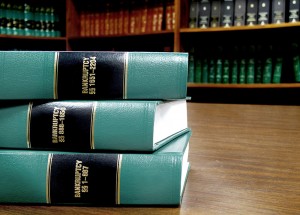- Home »
- Basics for Beginners »
- Dealing With Distress For Fun & Profit – Installment #10 – About the Automatic Stay
Dealing With Distress For Fun & Profit – Installment #10 – About the Automatic Stay
A written tour of business bankruptcy and its alternatives
 We discussed the automatic stay from the perspective of a secured creditor in Installment #9 of this series.This time we pan the camera back and look at the automatic stay from a broader and more general perspective. It is sometimes said that the two primary objectives of chapter 11 are to maximize the going-concern value of the bankruptcy estate and to assure equality of distribution among similarly situated creditors. The automatic stay furthers both of these goals. It preserves going-concern value by preventing creditors from picking apart the debtor one asset at a time—the “death by a thousand cuts” that can convert an operating business into little more than a pile of spare parts. At the same time, the automatic stay helps to achieve equality of distribution, by preventing one creditor from seizing assets before others have an opportunity to do so. In this manner, automatic stay protects not only the debtor, but it also protects creditors from one another.
We discussed the automatic stay from the perspective of a secured creditor in Installment #9 of this series.This time we pan the camera back and look at the automatic stay from a broader and more general perspective. It is sometimes said that the two primary objectives of chapter 11 are to maximize the going-concern value of the bankruptcy estate and to assure equality of distribution among similarly situated creditors. The automatic stay furthers both of these goals. It preserves going-concern value by preventing creditors from picking apart the debtor one asset at a time—the “death by a thousand cuts” that can convert an operating business into little more than a pile of spare parts. At the same time, the automatic stay helps to achieve equality of distribution, by preventing one creditor from seizing assets before others have an opportunity to do so. In this manner, automatic stay protects not only the debtor, but it also protects creditors from one another.
The Basic Framework of Bankruptcy Code § 362
Section 362(a) lists the actions that are automatically stayed upon a bankruptcy filing. The rest of § 362 is laid our fairly straightforwardly: Section 362(b) sets forth exceptions to the automatic stay; Section 362(c) describes the duration of the automatic stay; Section 362(d) sets forth the grounds for seeking relief from the automatic stay; Section 362(e) provides the time framework under which the courts must operate in response to a motion for relief from the automatic stay; Section 362(f) provides a limited mechanism for emergency relief from the stay; Section 362(g) allocates the burdens of proof in a motion for relief from stay; and Section 362(h) provides for damages in the event that a party willfully violates the automatic stay.
What Is Stayed?
Section 362(a) contains a long list of actions that are stayed upon the filing of a bankruptcy petition. Among other things, a creditor cannot file or continue to litigate a lawsuit against the debtor to recover on claims that arose before the petition date. This does not prevent litigation against the debtor based on post-petition conduct, which can be filed in any court that has jurisdiction. Nor can a creditor: (a) seek to enforce a pre-petition judgment against the debtor; (b) perfect or enforce liens granted pre-petition; foreclose on collateral, terminate contracts on account of pre-petition defaults, or takeg any number of other actions against the debtor or its property. The stay halts rights of setoff as well. Thus, if a creditor and the debtor owe each other mutual pre-petition debts arising from different transactions, the creditor cannot, without relief from the stay, apply the debt owing to it against the debt it owes. However, if the debtor’s obligation to the creditor and the creditor’s obligation to the debtor both arise from the same transaction, the creditor may have a right of recoupment (a close relative to setoff). Courts hold that the right of recoupment is not subject to the automatic stay.
Exceptions to the Automatic Stay
Bankruptcy Code § 362(b) provides certain exceptions to the automatic stay. They include: actions by parties to securities contracts to close out open positions; eviction of a debtor by a landlord where the lease has been fully terminated prior to the bankruptcy filing; actions by taxing authorities to conduct tax audits, issue deficiency notices, demand tax returns and make tax assessments; and the right of a governmental unit to enforce its police and regulatory power.
Is Stay Relief Necessary?
Attorneys are often called upon to advise on whether a proposed action would constitute a violation of the automatic stay and would thus require filing a motion seeking relief from the stay before proceeding. Although the answer may be obvious in some cases, the following are examples of situations that are not so obvious: plaintiff believes that its lawsuit relates wholly to post-petition conduct, but the debtor alleges that it is based on pre-petition events; creditor believes that it is exercising a right of recoupment (not subject to the stay), while the debtor characterizes the action as a setoff, which is subject to the stay; party to a contract with the debtor believes that it has the right to terminate the contract based on a post-petition default without court approval, while the debtor takes the position that doing so constitutes an act “to obtain possession of property of the estate or of property from the estate or to exercise control over property of the estate,” and is therefore subject to the automatic stay; and creditor with a contract to supply goods to the debtor wants unilaterally to modify credit terms post-petition to minimize its risk, but the debtor argues that the unilateral contract modification violates the stay. Situations like these are bothersome, at best because creditors often want to act quickly but the consequences for violating the automatic stay can be harsh.
Process for Getting Stay Relief
To obtain stay relief a creditor must commence a contested matter by filing a motion under § 362(d). Section 362(e) provides that the court may hold a preliminary hearing followed by a final hearing on a motion for relief from the stay, or may consolidate the two and just hold a single hearing. Except in particularly complex matters, courts tend to hold a single hearing, but local practices vary. The court must hold a preliminary hearing within 30 days after a motion for stay relief is filed, unless the movant agrees otherwise. If the initial hearing is a preliminary hearing, then a final hearing must be concluded by no later than 30 days after the conclusion of the preliminary hearing, unless the parties agree otherwise or the court finds “compelling circumstances.” These provisions are intended to provide a prompt resolution of motions for relief from stay, recognizing that creditors who are entitled to relief from the stay often face substantial risk and imminent harm. A stay relief motion can be deal with on an expedited basis under § 362(f) when immediate relief is necessary to avoid irreparable harm.
Three Bases for Stay Relief
Section 362(d) provides three grounds for obtaining relief from the automatic stay:
- § 362(d)(1) – The first ground for obtaining relief from the automatic stay is set forth in § 362(d)(1), which states that relief from the stay may be granted “for cause, including the lack of adequate protection of an interest in property …”
Regular readers of this column will recall that we described the concept of adequate protection in our most recent installment. Secured creditors and certain other parties who have an interest in property of the estate are entitled to adequate protection to protect against diminution in the value of their collateral (or other property in which they have an interest) during the chapter 11 case.
For example, a mortgage lender whose pre-petition collateral is diminishing in value during the bankruptcy case may be entitled to periodic cash payments to compensate for the loss in collateral value. If a party is entitled to adequate protection, but the debtor is unable or unwilling to provide such adequate protection, § 362(d)(1) provides for stay relief. Although § 362(d)(1) refers to “cause, including the lack of adequate protection …” it does not specify what else may be “cause” other than lack of adequate protection. Courts have broad discretion in finding other cause. Secured creditors who want to foreclose on their collateral are just one group in the universe of parties who often seek stay relief.
Others include contract parties who want to terminate contracts, litigants who want to continue with litigation (or arbitration) in a non-bankruptcy foru,m and plaintiffs who want to name the debtor in a lawsuit in order to seek payment under an insurance policy. Again, the concept of “cause” under § 362(d)(1) is flexible enough to allow the court to balance the interests of the non-debtor party against the interests of the estate, and act accordingly.
- § 362(d)(2)– Bankruptcy Code § 362(d)(2) provides that a secured creditor may obtain relief from the automatic stay with respect to an act against property of the bankruptcy estate if “(A) the debtor does not have an equity in such property, and (B) such property is not necessary to an effective reorganization.” We wrote about this in our most recent installment.
- § 362(d)(3)– Bankruptcy Code § 362(d)(3) deals with a small subset of bankruptcy cases—single-asset real estate bankruptcy cases involving less than $4 million in secured debt.
Single-asset real estate bankruptcy cases are generally two-party disputes. Secured creditors tend to argue that these are not “real” reorganization cases, and that it is unfair to impose delay and market risk on the secured creditor. Debtors, meanwhile—or in any event their partners or shareholders—use the breathing room afforded by the stay to wait for market improvement, seek to enhance value through leasing or a going-concern sale, or at least to delay the tax effect of a foreclosure.
This is, of course, a slight oversimplification of these cases, but nonetheless they are a special category of chapter 11 cases and do not resemble the typical business reorganization contemplated by chapter 11. Congress enacted a special provision aimed at ensuring that these cases move quickly or, in the event that this does not happen, that the secured creditor nevertheless obtains relief.
Section 362(d)(3) provides that a secured creditor such a case is entitled to relief from the stay to foreclose on its collateral unless the debtor has filed a reorganization plan that has a reasonable prospect for confirmation or begins paying monthly interest to the secured creditor at a market rate of interest by no later than 90 days after the bankruptcy filing.
To read other installments in this series, click here.
For a great discussion on insolvency, we recommend this webinar and this webinar. You can also learn about federal equity receiverships here, and get advice on what to do when your business is struggling here.
About George Kuney
Prior to joining the faculty of the University of Tennessee College of Law, where he is now an emeritus professor, in 2000, Professor Kuney was a partner in the San Diego office of Allen Matkins Leck Gamble & Mallory LLP where he concentrated his practice on insolvency and reorganization matters nationwide. Before that he received…

About Jonathan Friedland
Jonathan Friedland is a principal at Much Shelist. He is ranked AV® Preeminent™ by Martindale.com, has been repeatedly recognized as a “SuperLawyer” by Leading Lawyers Magazine, is rated 10/10 by AVVO, and has received numerous other accolades. He has been profiled, interviewed, and/or quoted in publications such as Buyouts Magazine; Smart Business Magazine; The M&A…

Related Articles
Bankruptcy Considerations in a Collections Action
What Secured Lenders Should Know If Their Borrower Files for Bankruptcy
Selling Distressed Assets: The Assignment for the Benefit of Creditors Alternative
Chapter 11 Reporting Requirements: How Debtors Must Stay Transparent
Dealing with Corporate Distress 07: Chapter 11 is Not Always the Answer: Strategic Alternatives For and Against Distressed Businesses
3 Special Issues in Healthcare Restructurings
